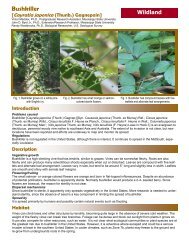RATopic1_95 - Geosystems Research Institute - Mississippi State ...
RATopic1_95 - Geosystems Research Institute - Mississippi State ...
RATopic1_95 - Geosystems Research Institute - Mississippi State ...
You also want an ePaper? Increase the reach of your titles
YUMPU automatically turns print PDFs into web optimized ePapers that Google loves.
geographically structured genetic diversity in its native range, similar to M. prodenialis in its native range. As expected,<br />
Cactoblastis cactorum in Florida has far reduced genetic diversity relative to its native range (5 vs. 55 cytochrome oxidase<br />
I [COI] haplotypes); however,<br />
this diversity was geographically<br />
structured, with a<br />
Gulf Coast clade, an Atlantic<br />
Coast Clade, and a more widespread<br />
clade overlapping these<br />
other two. The data supported<br />
published inferences of multiple<br />
introductions to Florida, but only<br />
from the nearby Caribbean<br />
range.<br />
We have submitted a manuscript<br />
based on these genetic analyses,<br />
and we are beginning the work<br />
of integrating the results into our<br />
environmental modeling work.<br />
The genetic results also form the<br />
basis for continued collaborations<br />
with the USDA ARS scientists<br />
at Tifton and Buenos Aires,<br />
Argentina, as well as one or<br />
more subsequent journal manuscripts.<br />
Figure 3. Preliminary map of expected environmental envelope of Cactoblastis cactorum<br />
in southeastern US, based on environmental data for research conducted in Argentina.<br />
Expanded inset shows overlap of most likely habitat (darkest red color) with<br />
known locations in South Carolina (blue dots). Large yellow dots indicate some of the<br />
known C. cactorum locations from Florida.<br />
Environmental tolerance models for Cactoblastis<br />
We have begun comparative habitat modeling approaches aimed at testing hypotheses regarding factors influencing the<br />
distribution of C. cactorum across Florida and other areas. This work, and a field study completed during summer 2008,<br />
suggest the moth‟s distribution is strongly influenced by the presence of its preferred host species (or that the two are<br />
mutually influenced by one or more environmental factors). We presently are expanding this work to evaluate potential<br />
habitat for the moth in areas of the Gulf Coast beyond the Florida-Alabama distribution (Figure 3). Thus far, models<br />
agree closely with known distribution of the moth, but we are now engaged in comparing modeling approaches prior to<br />
submitting manuscripts on these studies.<br />
We also have begun work to integrate habitat modeling studies with results we have obtained to date from our genetic<br />
analyses (i.e., modeling habitat for specific genotypes). We have two manuscripts in development based on this habitat<br />
modeling work, and a third is in the planning stages; all will specifically address the roles of environment and genetics<br />
on distribution of C. cactorum. We also will be using these findings to help direct the collaborative work with USDA<br />
ARS scientists. Initial manuscript submission is targeted for January 2010; grant proposal submission is targeted for<br />
July 2010.<br />
2009 USGS Annual Report 24 <strong>Mississippi</strong> <strong>State</strong> University’s <strong>Geosystems</strong> <strong>Research</strong> <strong>Institute</strong>




